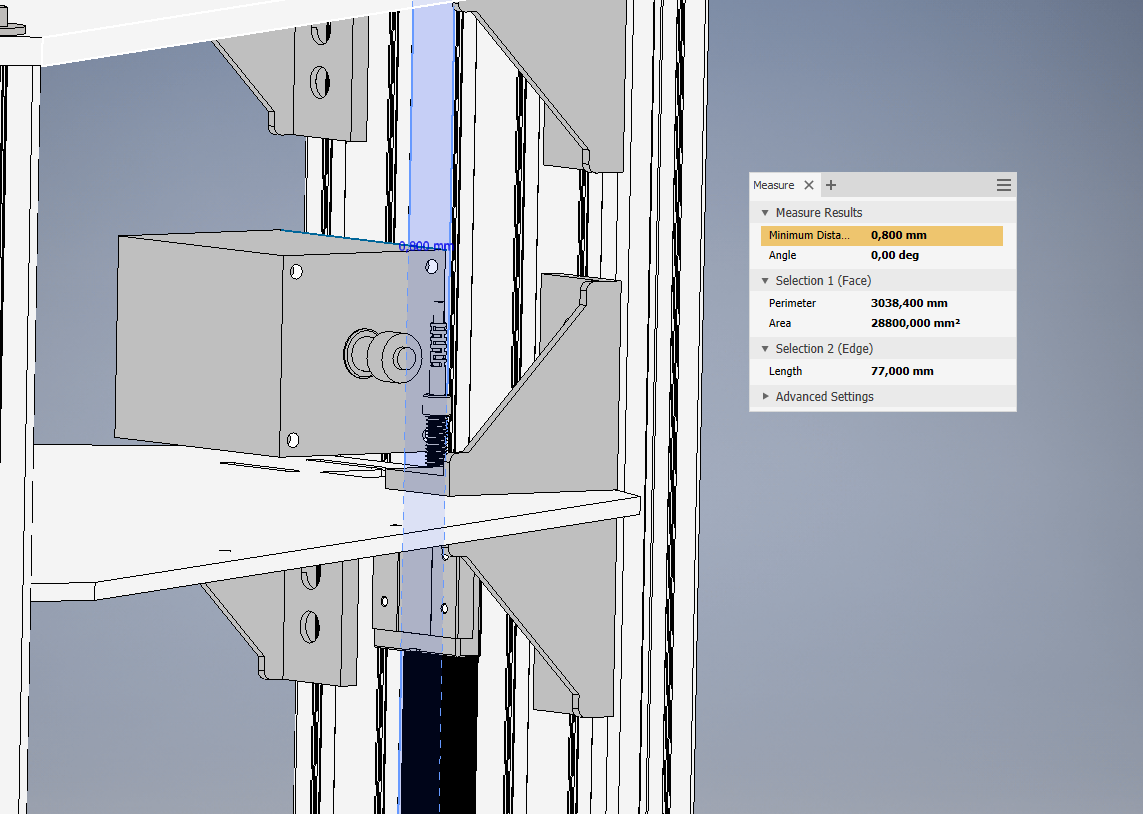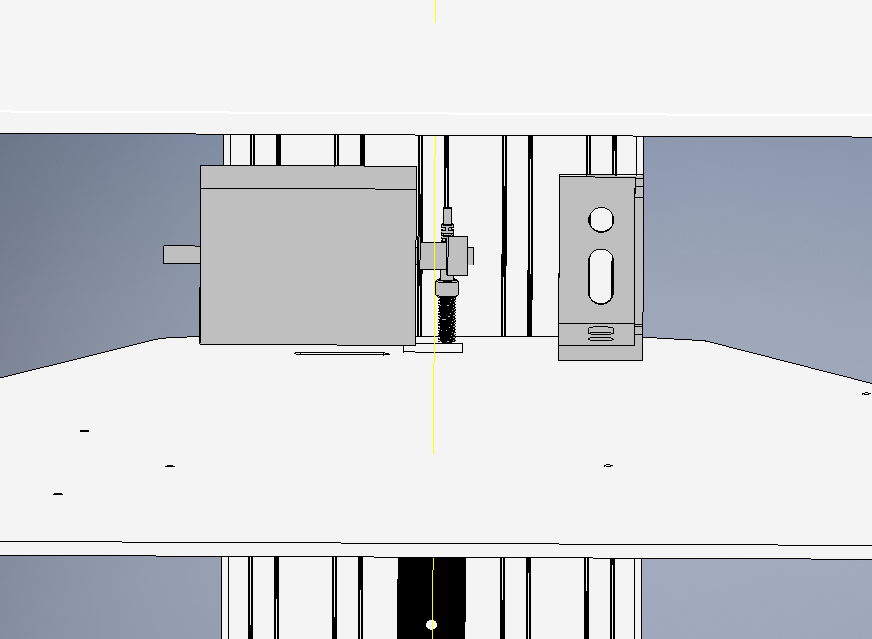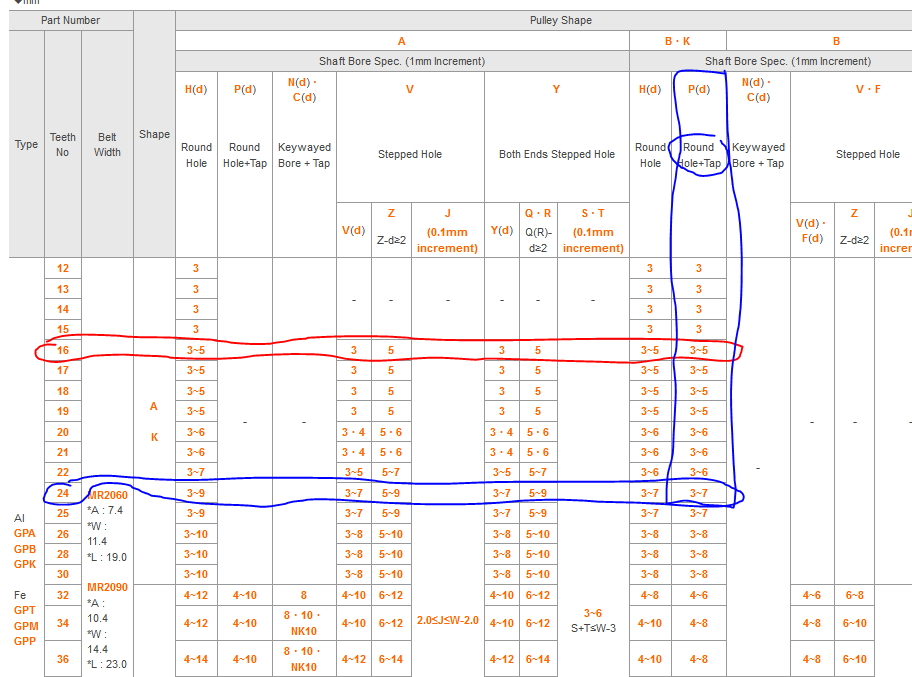Delta stepper upgrade - advice welcome
-
Since nema 23's have seemingly come a major contender, I quickly sketched one up and placed it in my current CAD design. Low and behold there is 0.8 mm clearance between the side of the tower extrusions and the side of the stepper. This all assuming noting changes to where the belts sit compared to their current place, which I would prefer if at all possible.
On the back side their seems to be just enough meat to the lower plate to attach some bracket locating the back bearing. What has me worried though is the length of the front shaft, it is 20.6 mm long according the specs (for the 3rd moon industries). A quick glance on some local webstores shows me that pulleys for 9 mm wide belt are 16 mm heigh, leaving just 4 mm for a bearing on that side.


-
@arhi said in Delta stepper upgrade - advice welcome:
@Nxt-1 said in Delta stepper upgrade - advice welcome:
@arhi seems to confirm this as well.
I have nema23 running darwin printer's not sure how that relates to delta (never did anything wrt delta) and I print PP and HDPE on my darwins - think 8-10mm/sec printing, I'm not sure your delta can even move that slow

My nema23 also run my mill and that's also nowhere close to what you want to go at so what I'm saying is please use the calculator

https://www.reprapfirmware.org/
- go to EMF calculator
- punch in your data
- see if motor will run at speed you want it to
I feel those motors will work ok on delta with 24V but that online calculator is worth 100000000000x more then my feelings

Sadly the calculator is not kind on me. I punched in the numbers for the nema 23 on the left and the numbers for the motor I am using (from aliexpress so how accurate are they?) on the right. The first image is 200 mm/s moves (travels) and the 2nd with something more realistic for actual printing.
One thing to note though, the calculator outputs the speeds at which the torque starts to drop but gives no info on how much is drops in function of speed. In the end it might be fine actually.


-
@Nxt-1 said in Delta stepper upgrade - advice welcome:
One thing to note though, the calculator outputs the speeds at which the torque starts to drop but gives no info on how much is drops in function of speed. In the end it might be fine actually.
From my experience with high inductance motor on 40:1 geared extruder where high speeds are required and error I was getting @dc42 explained that drivers will complain if they can not push asked current into the motor by applying maximum voltage. So if you are running Vin at 24V, and you need let's say 4V for the 2A you configured your stepper at, if back EMF is over 20V there's not enough voltage driver can apply to push 2A in. How much loss in torque due to lower current is impossible to say without actual graphs from the motor manufacturer but how much less current is supplied you can get from that calculator by using the less current in the motor current field. So you setup calculator with 2A and see the data, then setup 1.9A and see the data etc etc ..
-
@arhi said in Delta stepper upgrade - advice welcome:
@Nxt-1 said in Delta stepper upgrade - advice welcome:
One thing to note though, the calculator outputs the speeds at which the torque starts to drop but gives no info on how much is drops in function of speed. In the end it might be fine actually.
From my experience with high inductance motor on 40:1 geared extruder where high speeds are required and error I was getting @dc42 explained that drivers will complain if they can not push asked current into the motor by applying maximum voltage. So if you are running Vin at 24V, and you need let's say 4V for the 2A you configured your stepper at, if back EMF is over 20V there's not enough voltage driver can apply to push 2A in. How much loss in torque due to lower current is impossible to say without actual graphs from the motor manufacturer but how much less current is supplied you can get from that calculator by using the less current in the motor current field. So you setup calculator with 2A and see the data, then setup 1.9A and see the data etc etc ..
I understand how back emf works and why the there is a loss of torque, that is not the issue. Calculating how much torque is lost is the interesting part. But as you pointed out correctly, that is purely dependent on motor design and thus can never be calculated by a simple calculator. I was just complaining that the calc can't do it, even there is no way it could

-
@Nxt-1 said in Delta stepper upgrade - advice welcome:
I was just complaining that the calc can't do it, even there is no way it could
yes, but like I said, you can see at that speed how much current will be supplied to the motor by using different current settings in the calculator
 ... and asuming some linear drop in torque with current is safe bet imo at those speeds
... and asuming some linear drop in torque with current is safe bet imo at those speeds -
@arhi said in Delta stepper upgrade - advice welcome:
@Nxt-1 said in Delta stepper upgrade - advice welcome:
I was just complaining that the calc can't do it, even there is no way it could
yes, but like I said, you can see at that speed how much current will be supplied to the motor by using different current settings in the calculator
 ... and assuming some linear drop in torque with current is safe bet imo at those speeds
... and assuming some linear drop in torque with current is safe bet imo at those speedsAh, I understand now. Thanks for the insight.
For the nema 23 the current at which emf due to inductance becomes 24 V is just 920 mA (@200 mm/s). Assuming the linear relation between current and holding torque, that would leave me with 73.6 Ncm. That is still more then just about any nema 17 motor I have seen though. Leading me to believe that this is a non issue.
-
So the moonsindustries.com webpage for the nema 23 that is the highest contender at the moment, specs the stepper at 3.9 mH inductance. While the moonsindustries.eu catalogue (page 40) specifies winding inductance at 6.9 mH.
My guess this has to do with taking the inductance of one coil or both combined. It does confuse me to say the least. Any have any insight in this?
-
-
2.8A/phase
-
.6Nm
-
2.1mH/phase
-
120gm*cm^2
-
single shaft, 6.35mm
- double shaft of above model
-
2.8A/phase
-
.6Nm
-
2.1mH/phase
-
150gm*cm^2
-
single shaft, 8mm
- double shaft of above model
Other options available
-
-
@sebkritikel Thank you for the suggestions. Do you have any experience with either of the motors you suggested?
I have also found these from the same supplier:
- Rated current: 2.80 A
- Holding torque: 1.32 Nm
- Inductance: 3.90 mH
- Rotor inertia: 290.0 gcm²
(6.35 mm shaft)
- Rated current: 2.80 A
- Holding torque: 1.40 Nm
- Inductance: 3.00 mH
- Rotor inertia: 310.5 gcm²
(8 mm shaft)
These see to be the longer versions of the ones you linked (54 mm vs 39 mm)
-
@Nxt-1 said in Delta stepper upgrade - advice welcome:
@sebkritikel Thank you for the suggestions. Do you have any experience with either of the motors you suggested?
I have also found these from the same supplier:
- Rated current: 2.80 A
- Holding torque: 1.32 Nm
- Inductance: 3.90 mH
- Rotor inertia: 290.0 gcm²
(6.35 mm shaft)
- Rated current: 2.80 A
- Holding torque: 1.40 Nm
- Inductance: 3.00 mH
- Rotor inertia: 310.5 gcm²
(8 mm shaft)
These see to be the longer versions of the ones you linked (54 mm vs 39 mm)
I don't have any experience with those models, however I do use two PKP264D28AA2 NEMA23s (2.8A/phase, 1.8°, 39mm, 74Ncm, 1.5mH inductance) on my printer, and they are fantastic.
I see you're trying to hit 200steps/mm with a 2mm pitch belt @ 16teeth on a pulley... I don't know how realistic it will be to find a pulley with 16 2mm teeth, and 6.35mm or greater shaft bore
Excerpt from Misumi's 2mm PowerGrip
 GT
GT 3 catalog listing
3 catalog listing
-
@sebkritikel Good point, a quick look at a local 3D printer parts supplier supports what you say. No 16T pulley with >5 mm ID bore. However jumping up to 20T pulleys (available in both 6,35 mm and 8 mm) is not per se a deal breaker for me. It will lower the steps/mm by 20% but I guess I can take that hit.
-
To keep a good overview of all the models that have been suggested, I am creating a google sheet with most characteristics in there. If you want to see a column added or spot an error be sure to give me a nudge.
You can find it here: Stepper Motor Chart
-
@Nxt-1 Ref the pulley thing, I hadn't even thought about that but I use 20 tooth in any case which is why I didn't have any problem finding ones with a bigger ID for my Nema23s.
-
I just added two more steppers from Nanotec. But I do not think they are major contenders as they are four coil motors (so eight leads). These specific ones have to wired so that only two coils are used to meet the spec requirements and then they are not that interesting anymore. Yet I added them for completeness sake.
-
@sebkritikel @deckingman I have just come to the sad conclusion that not only should I look at the correct shaft diameter, but length as well. For a 9 mm wide belt, the pulleys seem to be 20 mm wide. Most if not all of the steppers in the spreadsheet have ~20 mm main shafts. This does not leave any room at all for a bearing in front.
Wanting to add external bearings to motor shaft is partly what parked the whole idea of upgrading steppers, and is fully what lead to dual shaft steppers. I do not what to hijack this thread to talk about that, that is what this thread is meant for.
-
@Nxt-1 Ahh sorry. I was thinking that simply moving to NEMA 23s with bigger bearings would suffice. I didn't realise that even with bigger bearings, you still want to add extra support to the shaft.
-
@deckingman said in Delta stepper upgrade - advice welcome:
@Nxt-1 Ahh sorry. I was thinking that simply moving to NEMA 23s with bigger bearings would suffice. I didn't realise that even with bigger bearings, you still want to add extra support to the shaft.
That was the idea yeah, but you might be right that I should keep an open mind. The larger bearings in nema 23 motors might suffice just like that. Although there is no way of knowing that before I commit to a purchase I guess.
-
@Nxt-1 For info, for some time now I've been considering using "remote" motors. That is to say, use an "axel" with big beefy bearings at each end and two pulleys in the middle. One pulley being connected to the main printer belts, the second connected to the motor with a short continuous looped belt. That means that one could run with much higher (main) belt tension because the small stepper motor bearings wouldn't be subjected to the loads. But whether high belt tension would offer any benefit on my printer remains to be seen. I have a sneaky suspicion (unverified by any testing or analysis) that too high belt tension might cause steppers to have a tendency to "jump" to the nearest whole steps due to the sideways load on the bearings.
Another possible use for this "remote motor" arrangement is that one could use gearing with a small pulley on the motor shaft and a large one on the main belt shaft. In theory, this would increase effective torque and/or positional resolution, But then again, it might not because stepper motor torque drops off with speed and the motors would be turning faster. On the other hand, a big gear on the motor driving a small gear on the shaft would make for higher speeds at the expense of positional resolution. Sop quite a few options which would need to be evaluated.
I guess this is where we came in......
-
@Nxt-1 said in Delta stepper upgrade - advice welcome:
So the moonsindustries.com webpage for the nema 23 that is the highest contender at the moment, specs the stepper at 3.9 mH inductance. While the moonsindustries.eu catalogue (page 40) specifies winding inductance at 6.9 mH.
My guess this has to do with taking the inductance of one coil or both combined. It does confuse me to say the least. Any have any insight in this?
I just got back from Moons EU and they informed me that the 3.9 mH is a typing error and it should be 6.9 mH, which is quite a bummer. As it turns out actually all of the inductance of the moon' steppers in the sheet are mismatched with their catalog. I have replied to moon' CS with that information and will await their response.
-
This might sound like a crazy suggestion...
What if you used two stepper motors? One of them disconnected, facing the other one, just as a support shaft? Basically, the amount that the drive pulley extends past the end of the motor shaft can be supported by the shaft of the other stepper.
Another crazy Idea: find a bearing block with a bearing ID large enough to go around the part of the pulley with the set screw. Support the pulley directly!
I'm full of crazy ideas.